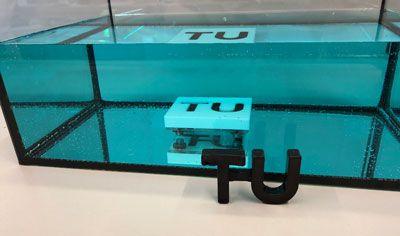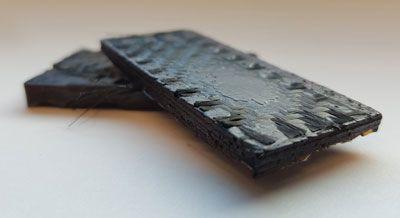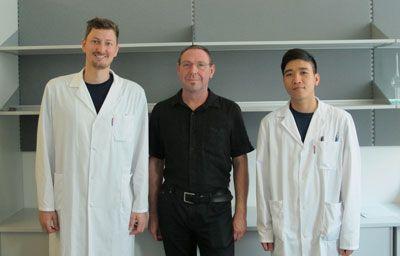 At the Vienna University of Technology, a special formula for an epoxy resin was developed. It can be used for fiber-reinforced composites in aircraft, automobile or shipbuilding and is even suitable for underwater remediation. Within seconds, the new material can change completely:
At the Vienna University of Technology, a special formula for an epoxy resin was developed. It can be used for fiber-reinforced composites in aircraft, automobile or shipbuilding and is even suitable for underwater remediation. Within seconds, the new material can change completely:
In the beginning it is transparent, it can be liquid or pasty. If you irradiate it with the right light at any point, all the special resin begins to solidify and takes on a dark color. The special epoxy resin formula that makes this possible has been patented. Now it was possible to drain this process even under water. Thus, the new epoxy resin can be used for tasks that were previously very difficult to solve - for example, to cement cracks in bridge piers or dams under water, or to repair pipes during operation.
Also new is that this special epoxy resin can also be used in conjunction with carbon fibers or carbon fiber mats. This results in a wide range of applications in aircraft construction, wind turbines, ship and boat building or in the automotive industry - wherever you want to combine the highest mechanical properties with a particularly lightweight design.
Ordinary material with unusual addition
 Epoxy resins are standard materials used in industry for many different purposes, such as isolating electronic components or fixing mechanical parts. The research group of Prof. Robert Liska (Institute of Applied Synthetic Chemistry, Vienna University of Technology) is developing additives that can be added to ordinary epoxy resin to adjust its properties and enable targeted curing at the touch of a button.
Epoxy resins are standard materials used in industry for many different purposes, such as isolating electronic components or fixing mechanical parts. The research group of Prof. Robert Liska (Institute of Applied Synthetic Chemistry, Vienna University of Technology) is developing additives that can be added to ordinary epoxy resin to adjust its properties and enable targeted curing at the touch of a button.
"We develop special compounds that trigger a chemical reaction through light," explains Robert Liska. "This can be a bright flash of visible light, we also have compounds that only react to UV light." At the point where the light hits the resin, a reaction is started that releases heat. This heat spreads and sets the chemical cascade in motion elsewhere - until finally the entire resin has cured in a short time.
"The key advantage of this method is that you do not have to illuminate the entire resin like other light-curing materials," explains Liska. "It's enough to hit any point with light. The rest then cures when it is deep in a dark gap that you want to kitten. "So far, two-component formulations have usually been used for such applications. They are first painstakingly mixed together directly on site and then have to be processed very quickly, before they harden on their own.
Interest from the industry
 Industry partners asked if this process would be possible even in the presence of "dark" fillers or fibers, since self-hardening epoxy resin would be extremely useful for such difficult applications. "Superficially, this idea contradicts any theory," says Liska. "The light is absorbed very well by the black carbon fibers, so it can not penetrate far into the material." Nevertheless, experiments at the Vienna University of Technology showed that this works very well.
Industry partners asked if this process would be possible even in the presence of "dark" fillers or fibers, since self-hardening epoxy resin would be extremely useful for such difficult applications. "Superficially, this idea contradicts any theory," says Liska. "The light is absorbed very well by the black carbon fibers, so it can not penetrate far into the material." Nevertheless, experiments at the Vienna University of Technology showed that this works very well.
Also curing under water contradicts any theory. "One would expect the water to chemically react with the components of the resin during curing, and on the other hand, to carry off the heat needed to sustain the reaction." Surprisingly, however, the light-started self-curing process also worked underwater to let. "A key reason for this is that the chemical reaction makes the water boil," explains Robert Liska. "It forms so between the hardening resin and the surrounding water a thin protective layer of water vapor."
Now it is looking for other users from the industry to explore the possibilities of the special resin. In addition to the use as glass and carbon fiber composites in the field of aircraft, ship and automobile construction is a particularly interesting area in the renovation of buildings. For example, cracks in buildings erected in the water could be stuck together with viscous resin and then hardened with a flash of light. Also, the rehabilitation of pipelines is a task that is often very difficult to solve - again, the use of the new resin would offer. "There are many possibilities - we hope for interesting new ideas," says Robert Liska.